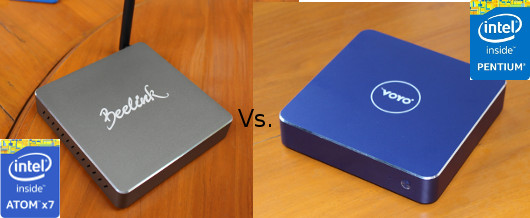Mini PCs based on Intel Apollo Lake processors have started selling, and they supposed to be upgrades to Braswell and Cherry Trail processor. I’ve recently had the chance to review Voyo VMac Mini mini PC powered by Intel Pentium N4200 quad core processor, that’s the fastest model of the Apollo Lake N series, and of course I ran some benchmarks, so I thought it would be interesting compare the results I got with an Atom x7-Z8700 “Cherry Trail” mini PC, namely Beelink BT7 which I reviewed last year.
Both machines are actively cooled with a small fan, and storage performance is similar, albeit with a slight edge for the Apollo Lake SSD. A ratio greater than one (green) means the Apollo Lake processor is faster, and if it is lower than one (red) the Cherry Trail processor win.
| Benchmark | Beelink BT7 Intel Atom x7-Z8700 @ 1.6 / 2.4 GHz (2W SDP) |
Voyo (V1) Vmac Mini Intel Pentium N4200 @ 1.1 / 2.5 GHz (6W TDP) |
Ratio |
| PCMark 8 Accelerated | |||
| Overall Score | 1,509 | 1,846 | 1.22 |
| Web Browsing – JunglePin | 0.59309 s | 0.52267 s | 1.13 |
| Web Browsing – Amazonia | 0.19451 s | 0.18459 s | 1.05 |
| Writing | 8.53975 s | 6.89837 s | 1.24 |
| Casual Gaming | 7.96 fps | 10.38 fps | 1.30 |
| Video Chat playback | 29.99 fps | 30.02 fps | 1.00 |
| Video Chat encoding | 301 ms | 196.66667 ms | 1.53 |
| Photo Editing | 0.65544 s | 0.45915 s | 1.43 |
| Passmark 8 | |||
| Passmark Rating | 846 | 1,052.1 | 1.24 |
| 3DMark | |||
| Ice Storm 1.2 | 23,999 | 23,511 | 0.98 |
| Cloud Gate 1.1 | 2,185 | 2,347 | 1.07 |
| Sky Diver 1.0 | 1,131 | 1,384 | 1.22 |
| Fire Strike | 276 | 267 | 0.97 |
The performance is usually faster in the Apollo Lake processor by between 5 to 50+% depending on the tasks with video encoding and photo editing gaining the most. Browsing is only marginally faster by 5 to 13%. PCMark8 reports a 30% higher frame rate for casual gaming, but 3DMark does not how that much improvement, and in some cases not at all, except for Sky Diver 1.0 demo. Intel Atom x7-X8700 SoC comes with a 16EU Intel HD graphics Gen 9 @ 200 / 600 MHz, while the Pentium SoC comes with 18 EU (Execution Unit) of the same gen9 GPU @ 200 / 750 MHz, and should be a little faster in theory.
So based on those results, there’s a clear – although incremental – performance improvement using Apollo Lake over Cherry Trail, but depending on the use case it may not always be noticeable in games or while browsing the web.

Jean-Luc started CNX Software in 2010 as a part-time endeavor, before quitting his job as a software engineering manager, and starting to write daily news, and reviews full time later in 2011.
Support CNX Software! Donate via cryptocurrencies, become a Patron on Patreon, or purchase goods on Amazon or Aliexpress. We also use affiliate links in articles to earn commissions if you make a purchase after clicking on those links.






Could you do some rough power usage figures?
@The Cageybee
+1
@The Cageybee
+1 too
The quoted 6W TDP makes the Pentium a lot more hungry but the cpu might be able to sleep in more efficient ways and can idle at 1.1GHz so … it could be interesting
@The Cageybee
@renw0rp
@agumonkey
The power consumption question is more complex as it will depend on the board too.
That’s what I wrote in Beelink BT7 review last year:
and in Voyo VMac Mini review:
@cnxsoft
I like the ‘Ratio’ column in your benchmark tables – saves much time for readers. See you now add the idle power consumption for each device (5-7W for Cherry Trail, 6.4-7W for Apollo Lake device) as that is the state majority of users are in.
I think it helps any Processor benchmark comparison to include some form of comparative ‘Performance per Watt’ metric in the main article, or at least state the comparative consumption for most of the benchmarks, without having to search other reviews to put the ‘Ratio’ into perspective.
EXACTLY what i was hoping to read on this article. Great stuff and it illustrates perfectly how the 2 extra Execution Units provide a slighter better performance.
The next step would be to test this with PS360 era titles at 720p low settings to see how far we are getting. Since the Atom could fare reasonably and only missing out on late-gen titles, Apollo Lake would fare a tad better here.
It sucks for the price right now, but i can totally see this and the Atom one be a reasonably cheap excuse for a low-end game console that, thanks to its PC heritage can run more titles from the PS360 era than the last-gen consoles do, like Shattered Horizon and the like. I dont expect you to cover that ofcourse – That is way beyond the scope of this site.
Still, great article and mighty thanks for the comparison CNX. Seems that N4200 is the more popular choice of the Apollo Lake mini PC’s.
@cnx-soft
That’s perfect. So both systems are comparable from a power usage perspective. Interesting.
I think that 10bit hevc support is biggest upgrade
@paul
The BT7 *idles* with Ethernet connected and ScreenOff @1.6Watt on Ubuntu … I wonder how the N4200 does …
Apollo lake is reading arm instructions or no?
@Matt
Apollo Lake is a x86 processor so it does not support ARM instructions.
Now you can still run ARM instructions on it using emulation like QEMU, but it will be quite slow.